The Pakenham Bourkes 1939 - 2017 Part Two
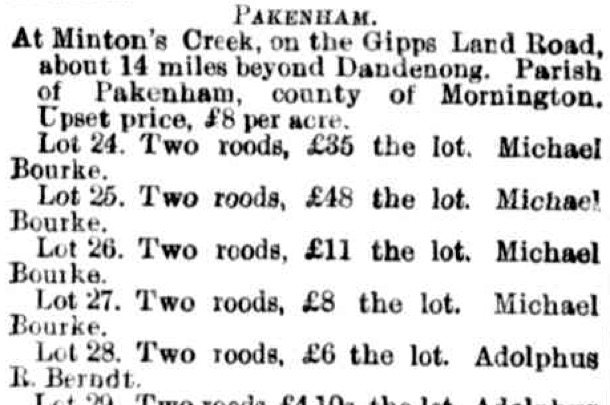
This example and a number of others are parcels of land around Pakenham.
Much of this investment was aimed at establishing their sons on large local properties.
Michael became an important citizen in the very early days of the Pakenham area. He was an inaugural member of the Berwick District Roads Board. Later this Board became the Berwick local council. Three of his sons were to spend time as Berwick Shire councillors, each of them spending time as Shire President. Michael was also post master and a trustee for the church, the school and the local cemetery. There is also record of nine nephews and nieces coming to Australia from Ireland, each receiving the best he could afford.
Michael died in 1977. Catherine took over the business and became quite a force in the district in her own right.
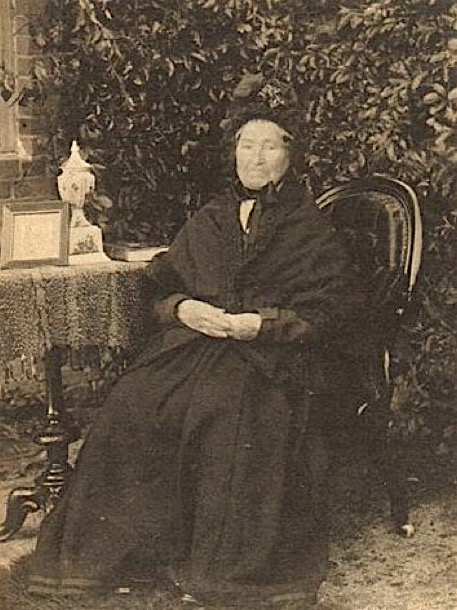
She lived into her nineties, dying in 1910. Her obituary describes her colourful life:
South Bourke and Mornington Journal Wednesday February 2, 1910
It is quite true to say that never in the history of this part of Victoria has the death of anyone been the general subject of so much interest and discussion as that of the late Mrs. Bourke who, with her husband, was one of the first settlers in Pakenham. The deceased lady was married in Ireland to Mr. Michael Bourke in the year 1838, being then 20 years old. Evidently the plans for their future had been prearranged, for the same day they shipped and sailed for Australia, arriving in Melbourne on St. Patrick's Day, 1839. They obtained employment as soon as they landed, managing a dairy farm at Moonee Ponds, where they remained until 1844, when, having saved money,they took up a run under a squatter’s licence on the Toomuc Creek, opposite Grant's orchard, then known as Bourke and Neville's station. There they remained for a number of years, until shortly before Black Thursday Mrs Bourke and her family took possession Bourke's Hotel, at that time known as the "Latrobe Inn," the husband remaining for a time at their station. On Black Thursday the whole district was in a blaze, and whilst Mr Bourke was trying hard to save the station property (water having been exhausted milk was brought into play and ultimately the run saved) word was brought to him that the hotel property at Pakenham was surrounded by fire. Galloping down there he found his wife and her children had saved themselves by crouching in the water in the bed of the creek. This is only one of many thrilling incidents in their lives.From the time they first arrived in this district to the time of Mr Bourke’s death in 1877, as they made money, they at once invested in land. Banks were unknown this side of Melbourne in those days, and their investments invariably turning out profitable, they slowly but surely acquired wealth. The name of Bourke and Bourke's Hotel will be, for generations to come, remembered as the pioneers and landmark of this part of Gippsland. The lives of Mr and Mrs Bourke have clearly proved what thrift, hard work and stout hearts can do in the settlement of this country, for at the time they arrived, the country was full of blacks camps along the banks of Toomuc Creek, and the country dense bush mostly. Yet out of all this Mr Bourke. made a fortune, buying up land as far away as Dandenong, and settling his sons on the land.
After his death Mrs Bourke continued to carry on and work hard, when there was no call for it, on the hotel property, and, as she repeatedly told the writer of this, she had more than her reward in the welfare and prosperity of her family, and she was proud of them, and well she might be, for her three surviving sons, Thomas, Daniel and David, have all been presidents of the Berwick Shire council, and all hold His Majesty's commission as Justices of the Peace, whilst the daughters are comfortably settled and highly respected. One of one of them, Miss Cissy Bourke has been (and still holds the position) of post mistress at Pakenham since a post office was first created.
With daughters like these, and sons holding the high positions they do, ever ready to give of their time and money in advancing the interest of the township and district, Mrs Bourke. has gone to her rest feeling fully rewarded for the years of her life devoted to and spent for their good. It would be difficult to find in the history of Australia, a parallel case of a man and a woman rising from the humblest rank of worker leaving behind them such a fortune and family so respected.
Mrs Bourke was probably the oldest colonist living at time of her death, having attained the ripe age of 91 years, being a colonist for 71 years and having resided at Pakenham for the last 67 years. She is said to have never, had a day's serious illness, and death was hastened by the severe heat three weeks ago.
Mrs. Bourke who died, on the 24th January at 9 in the morning, was-interred in the Pakenham cemetery on the 26th. A solemn Requiem High Mass was held in St. Patrick's Church from 10 to 12 a.m., the coffin being heavily draped in mourning, thronged with relatives and friends of the deceased. At the close of the Mass, the coffin was carried to the hearse and proceeded to the cemetery, a procession of carriages and horsemen fully half a mile in length and composed of people of all creeds following, and so was laid in her last resting place with sorrow and with respect: a good mother, a kind hearted woman, and a true colonist.
Michael and Catherine had fifteen children in total. Here in birth order is what we know of each of them:
James, born 1839, at Moonee Ponds. He was married twice: first to Johanna Conway in 1867, and secondly to Margaret Cahill in 1877. He had ten children all together, all girls. James’s property was in Dandenong, near the corner of Dandenong Road and the M1 freeway. He died in 1892 and is buried at Pakenham Cemetery.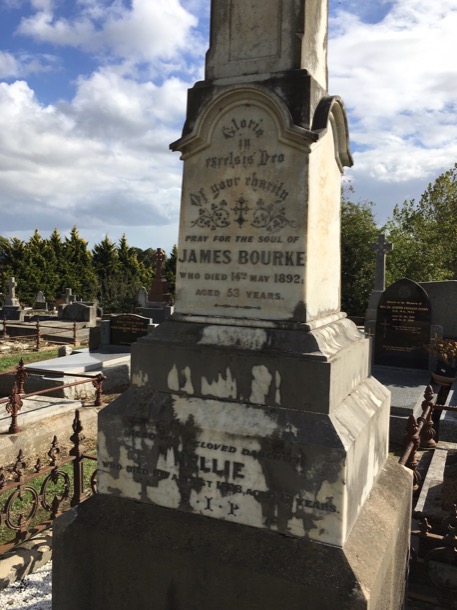
John was also born at Moonee Ponds, in 1840. He married Mary O’Neill in 1877. John and Mary lost their fist two children in infancy, but went on to have another five. The family settled in Leawood Park Rosedale, a long way from Pakenham. Today, Leawood is an Angus stud farm which has been in the same family, the Stuckeys, since 1944. It is a covenanted Trust For Nature property, protecting 18 hectares of important floodplain habitat along the Latrobe River. 
John died in 1892, He is not buried in the Rosedale cemetery, but his son John who died aged 4, a year before John senior died, is there. Mary went on to live until 1935.
Thomas was Michael and Catherine’s third son, also born at Moonee Ponds, in 1842. In 1875, Thomas married Jane Smith, daughter of another family who came from Shanagolden in Ireland, and settled in the Toomuc Valley. The Smiths probably travelled from Ireland on the same ship as Thomas’ parents.
Thomas and Jane moved to the property “Snowview”, which Thomas had “selected” some time earlier. They had four children. Thomas, like his father, was very prominent in local politics, serving on the Berwick Shire Council for forty-five years. During most of that time he went on horseback from his home at "Snowview" to attend the meetings at Berwick, and it was only through advancing age that he finally resigned from the council. He lived at “Snowview” right up to his death in 1929. It is now a heritage listed property, which remains in family hands to this day.
Thomas and family:
Mary Ann was born a year later, in 1843 the last to be born at Moonee Ponds. Mary died aged six. We know very little about this Mary, we don”t even now where she was buried. The family was living at Minton’s Run when she died, perhaps she was buried near the slab hut they lived in. The Pakenham cemetery wasn’t formally gazetted until 1865, though, reportedly, there were burials there before then. A devastating fire in 1944 burned most of the wooden grave markers in the cemetery anyway, so much of the historical graves are now unmarked.
The fifth child is Michael, born in the slab hut at Minton’s Run in 1844. Unlike the other sons, Michael did not take up life on the land, but became a lawyer. He married Ellen (Nellie) Doogan in 1884. Nellie was the daughter of Pyalong publican, Hugh Doogan. The family lived in Parkville, near the city of Melbourne. Michael and Nellie had six children, the second of whom, Hugh, was our grandfather.
Michael died in !908 and is buried with Nellie and their third son Austin, in the Kew cemetery.
Michael and Nellie's Parkville house: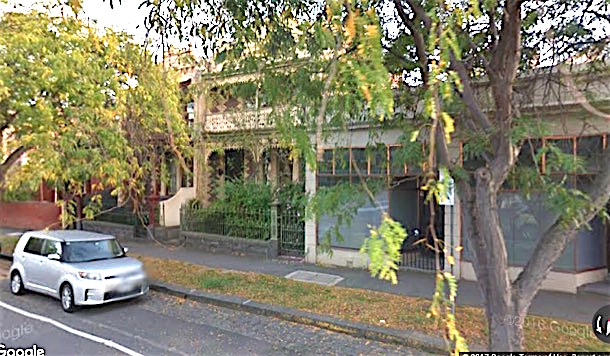
Michael and Nellie's grave: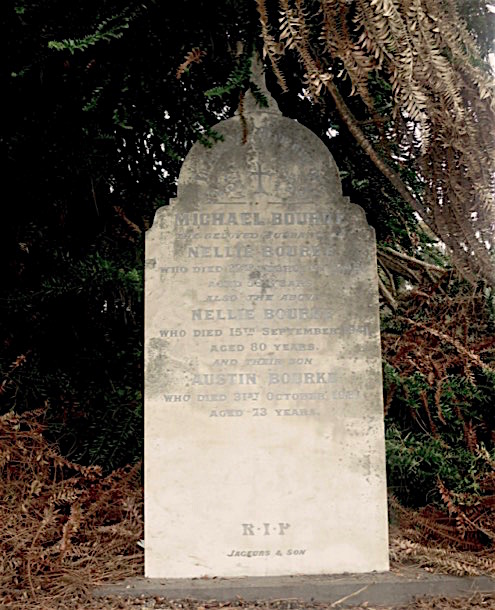
Catherine is the sixth child. She was born in 1845 at Minton’s run. She married Charles Billings in 1878. They lived in Prahran, in a house named “Pakenham”. It seems to have been an important family place, with births marriages and deaths all occurring there. Charles and Catherine had seven children and Catherine died in 1929, and is buried in the St Kilda cemetery with her sister Mary Lucy.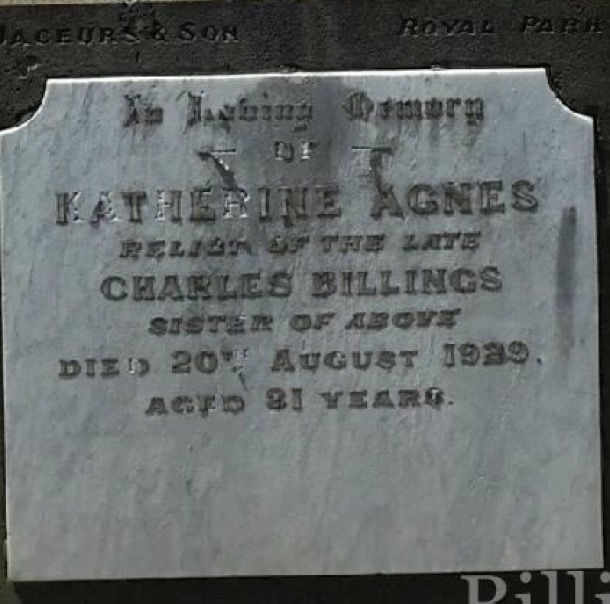
Daniel Bourke, was born in 1847. He was Michael and Catherine’s fifth son, Upon retirement from the Berwick Council, he is quoted as saying, “Our nation was not built on bloodshed, but on hard work”.
Daniel, like almost all of his brothers lived out this ethos on the land. Michael and Catherine seem to have imbued their children with the desire to do well, serve their community and ensure that their own children were also settled well. Daniel followed the family line. He married Fanny Levers who produced eight children and pre-deceased Daniel by only three years.
Daniel’s early years were spent in Pakenham where he owned Mt Bourke, some 400 acres, sold off from a larger property owned by the Hentys. This property is now in central suburban Pakenham, as we mentioned in the previous post. The heritage listed house was built one year after Daniel sold the property, probably by the new owners. David also owned the Gembrook Hotel in Pakenham.
What is notable about this article is that it also includes Catherine’s application for Bourke’s hotel, and Daniel’s brother Thomas, is the licensing magistrate!
It is Daniel’s public life in Pakenham that gives us some idea of the man. Daniel served on the Berwick Council for twenty years and it is the speeches from his farewell dinner that offer these insights. Fellow councillors were obviously very sorry to lose his services, as they commented that,
‘…his name will be remembered in Pakenham with pride and honour..’
‘Berwick Shire is losing on of its leaders.’
‘He was one of the largest-hearted men in the district….’
‘His calm, cool, warm-hearted manner won him friends from all ranks. He was in the full sense of the word a reliable man and a gentleman.’
Daniel held many other other positions the community, as President of many clubs, farming organisations, and was also regarded as a pillar of his Church and well regarded by others…’
Daniel’s own speech in reply to all these accolades is also revealing. In reply he says that it was the noblest duty of a man to help his neighbour and the magnificent national feeling that was through gathering particularly pleased him. Australia to him was the greatest country in the world.
This offers an insight into Daniel’s character but also to the ethos that appears to run through the family, and no doubt contributed to their success.
Daniel and his family moved to Stratford where he and David, his younger brother of Monomeith fame, owned another property, ‘llowalong’. Daniel and his and wife felt that there was not enough ‘scope’ for their sons in the district and it was for their sake they were leaving Pakenham. Daniel died at the ripe old age of 88 leaving one of his sons possibly James on the Stratford property.
Mary Lucy was probably the last child to be born at Minton’s Run. There are doubts about the date of her birth. Mary Ann had recently died, and this Mary was perhaps given her name. She died, unmarried and is buried in the St Kilda cemetery. On her grave it says she was aged 37, but this would make her born the same year as her namesake Mary Ann. Had she lied about her age? Is the information about the two Marys wrong, and they are the same person? We don’t have a grave for Mary Ann, so there are unanswered questions about these two. The fact that Catherine was buried in the same grave as Mary Lucy, and near to Prahran, when Catherine lived suggests that the two were close. Perhaps unmarried Mary lived with Catherine and Charles.
Ellen was the first child to be born at Bourke’s hotel right in Pakenham. She was born in 1851, the year of the big fire that burned the Minton’s Run property. She married John Augustus McKeone, of Port Albert Victoria. The couple lived at times in Beechworth and in Narrandera. They had a total of nine children. John died in 1895 and Ellen in 1934.
Milo was born in 1852. He never married. He died aged only 25, “after a short illness” at the home of his older sister Catherine, and is buried in the Pakenham cemetery.
Michael and Catherine’s youngest son David, was born in 1856. He married Mary Hunt in 1888. David had bought Monomeith Station in the mid 1800’s. It was originally 3000 acres comprising what is now the area of Monomeith and Caldermeade.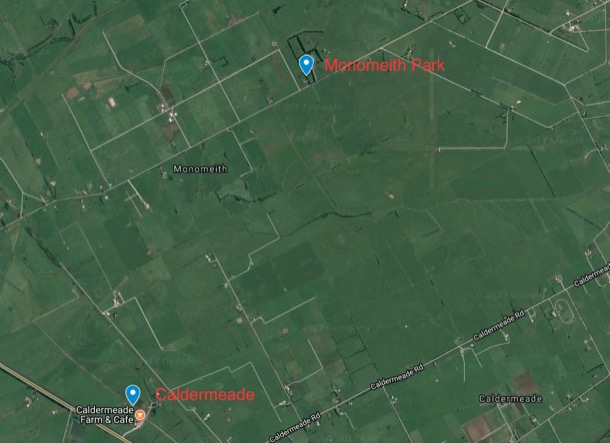
On the map you can see the World War two airstrip, south east of Monomeith Park. It was constructed as a RAAF fighter base to protect Yallourn where all of Melbourne’s power came from. In the end they only built two gravel strips, in the shape of a cross.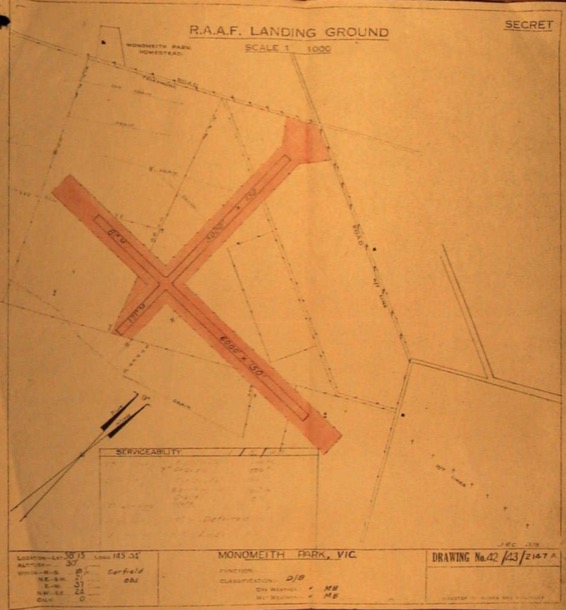
It was fine grazing land on black loam country and is part of the rich history of the early settlement of the area. Over the years hundreds of prime bullocks were driven to Newmarket sale yards in large mobs. According to local legend this feat was undertaken by the well-known character “little” Billy Matthews who reputedly drove the Monomeith mob all the way by himself.
In 1886 1000 acres of Monomeith was sold at auction, probably the swampy section. The carrying capacity of the land retained is referred to in, “Memoirs of a Stockman” by Harry Worthington Peck:
“However, the Bourke brothers [David’s sons, Michael and Hugh] at Old Monomeith Homestead of some 2000 acres have today the pick of the estate carrying some 3000 cattle of mixed ages and all fattening. This is probably a record for the Commonwealth and proves the virtue of top-dressing even on the richest natural pastures”
The Cattle King, Sir Sidney Kidman, visited Monomeith for both business and pleasure, another indication of how well known this property was.
In later years the property was again subdivided presumably between David’s two sons Michael and Hugh. Their descendants retained ownership until recently. Ironically after so many years in family hands, through three generations, we have discovered both the properties in advertisements in the real estate section of the Weekly Times.
Caldermeade was sold in 2016.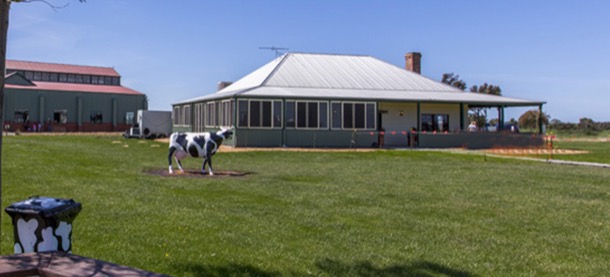
Through articles and advertisements for the property, in the local paper, we discovered more family history. For instance, only four years ago, there was an article in the Pakenham Gazette about Brian Bourke, the then owner of Caldermeade.
A fall from a horse, broken bones and 32 hours lying in a paddock would spell disaster for most 77-year- olds, but Hughie Bourke comes from tough stock. Fearing the worst, family and friends rallied together last week to rescue the stricken grandfather after he was reported missing last Thursday. Now recovering in The Alfred hospital with a shattered femur and pelvis, Hughie reckons he spent his marathon ordeal enjoying the company of animals on his Caldermeade property, but was disappointed to miss the day’s horse racing. Falling from his horse, he remained injured on the ground for almost a day and a half, watching the changing sky and surrounded by foxes and cattle. And while “the old cockie” has a long road to recovery ahead, he told his kids that it was a “bloody beaut” watching the clouds go down and sleeping next to the animals on his farm.”
Monomeith is on the market at the time of this post, July 2017, thus ending three generations of Bourkes running cattle on this property. An article published in the Pakenham Gazette describes the property:
‘Monomeith is heritage listed by the Shire of Cardinia because the house, which was built about 1899, and trees represent a long-term farming enterprise carried out by one family.
The old woolshed, and early picket fences and gateways that survive along the frontage and in some of the paddocks are a reminder of times gone by.
The large double-fronted weatherboard verandah farm house has been home to the Bourke family for more than a century.’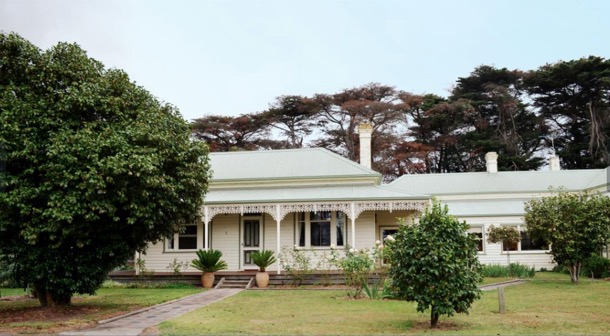
Margaret was the twelfth child of Michael and Catherine. We do not know the exact date of her birth but we know she married Robert Massey Coote in 1883. In 1886, in partnership with Lance Herbert the Cootes established a store and transport business in Orbost. They had three children. Robert died in 1891, and Margaret in 1935.
Agnes’ birth date is also unknown, but we know a little about her life. She married George Fraser of Aberdeen, Scotland. The family lived first in Nar Nar Goon and then in Aukland, New Zealand. They had six children, three born in Australia, and three in New Zealand.
Richard is the next child, but he died in infancy
Cecelia (Cissy) was Michael and Catherine’s fifteenth and youngest child. She never married.
The original Pakenham Post Office opened on 1 February 1859, with Michael as the postmaster. Catherine took over when Michael died in 1877, and Cissy took over from her, serving for many years. The history of Pakenham Post Offices is a bit garbled because, once the railway station opened, in 1977, there were two. Post Mistress was an important official role. For instance Cecelia’s name appears in 1909in the official Federal Gazette as the Electoral Registrar for Pakenham.
THE BOURKES : A RACING DYNASTY
From the early days at Bourke's hotel, Michael showed an interest in horse racing. We have no idea if this interest arose in the colony, where impromptu race meetings were common, or whether the interest came with him from Ireland. As Ireland has such a long and rich history of horse racing, this is quite likely.
Records show, that Michael and Catherine lent the paddock behind their hotel for the first race day picnics at Pakenham. This area was later named Racecourse Road. With great enthusiasm and involvement from Michael and his sons, racing flourished and in 1875 the Pakenham Racing Club was formed. Michael’s sons continued the family involvement, guiding the development of the club after Michael’s death in 1877.
Our direct descendant Michael, fourth son, left Pakenham for a law career in Melbourne. The rest of the family that remained in Pakenham continued to build a racing legacy.
David Bourke, the youngest son and owner of Monomeith Park, was a particularly good horseman and it is his line that continued the public involvement in racing through to the present day. David helped the Club to prosper in the early days, making his back paddock available for race meetings. This area was later named Racecourse Road, and was the site of the Pakenham Racing Club until 2014.
In the 1900’s the club fell into semi obscurity.and the Bourkes once more became involved in response to:
‘a letter from a local policeman to the Chief Secretary’s Office prompted an official letter being sent to the Pakenham Secretary Mr. A. L. Fairburn, requesting action be taken to rectify the situation.’
Hugh and Michael Bourke, David’s sons, came to the rescue, raising 4,000 pounds to reconstruct the course. The course was seven furlongs, 54ft. (1424m) in circumference.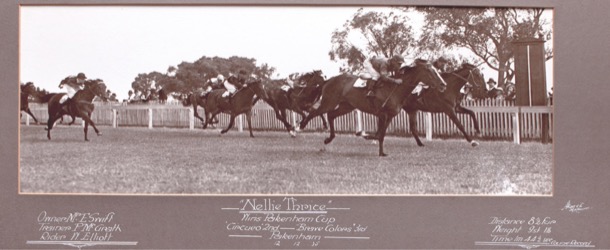
After David’s death it was his sons Hugh and Michael who played the crucial role of keeping the club alive and it continued to hold picnic race meetings. The land was leased to the club by the Bourkes for no fee on condition that profits were spent on public amenities.Finally despite pressure for the site to become Crown land,the Bourkes agreed to sell the track to the Pakenham Racing Club for 25 000 pounds ($50 000). The deal was finalised in 1957.
"It was about a quarter of what it was worth,but back then our family wanted it to stay a racetrack forever and we always thought it would, " Hughie Bourke is quoted as saying.
The Bourkes maintained their interest in the club after the sale, serving on the committee and fulfilling other roles. Michael, David and Gavan held the position of Secretary between the years 1926 and 1999. A number of other family members also served on the committee for lengthy periods of time.
Early this century as the suburban sprawl reached Pakenham the racing club committee decided to sell the land and use the considerable profits to redevelop a new racing track at Tynong on a site of 246 hectares. In February 2014 the cub hosted the last race meeting at the old site and at the time, Gavan Bourke commented that it was sad that the old track,on a 27 hectare site had been sold for redevelopment to accomodate the urban sprawl.
The Bourke family interest in racing is also evident in positions held within the Victorian Racing Club [VRC] by David’s direct descendants.
David Bourke [1930-2005] David’s grandson, was a racing administrator for 60 years. He began his career after his father’s death when aged 19 he took over as Secretary of the Pakenham Racing Club.
He served on the VRC committee for twenty years, seven years, as Chairman. In this role he presided over the nation's most famous race, the Melbourne Cup from 1991 until 1998. The David Bourke Provincial Plate is run annually in June at Flemington, the Saturday of the Queen's Birthday weekend.
David’s brother John, also had a career in the thoroughbred racing industry. He was employed by the VRC as the Veterinary Steward. During a long and distinguished career he was instrumental in the introduction of drug testing of thoroughbreds. Dr Bourke went on to become a world authority on equine medicine and the use and effect of drugs on horses.
So from the first race meeting in Pakenham, in the early days of the Colony of Victoria, Michael’s and Catherine’s descendants have been involved in the horse racing industry. Some, such as our line, have had a recreational interest in horse racing whereas others, such as David’s line, produced several Bourkes who made their careers in thoroughbred racing. Quite a family affair through the generations!
